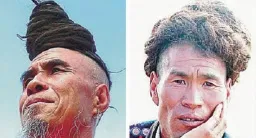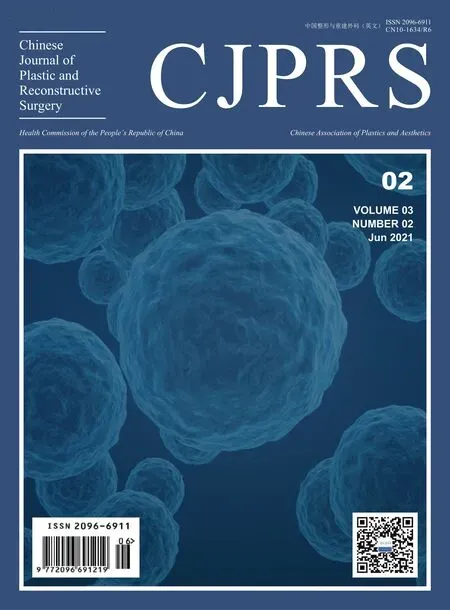The Practice of China’s Cosmetic Medicine Dated Back to 3 800-4 800 Years Ago
Wei WANG ,Xiaoxi LIN ,Yuguang ZHANG ,Qingfeng LI
1 Department of Plastic and Reconstructive Surgery,Shanghai Ninth People’s Hospital,Shanghai Jiao Tong University School of Medicine,Shanghai 200001,China
ABSTRACT Objective To investigate the developmental history of cosmetic surgery and cosmetic medicine in China.Methods The history of cosmetic surgery and cosmetology in China was explored via a review of the literature reported across the globe and the archeological discoveries recorded in China.Results The ancient underground city of“Sanxingdui”,discovered in Guanghan,Sichuan,China,was built between 1 800 and 2 800 BC.Many bronze figure sculptures with decorative perforations in the earlobe area were unearthed there,making it perhaps the earliest record of cosmetic surgery practice in the world.The practice of decorative perforations in the earlobe predates the practice of nose jobs found in ancient India.The Prescriptions for Fifty-two Diseases from the Western Han Dynasty,unearthed in Mawangdui,Changsha,Hunan Province,recorded the treatment of vitiligo in traditional Chinese medicine.This might be one of the earliest records of aesthetic medicine in the world.Conclusion China is one of the earliest birthplaces of cosmetic surgery and cosmetology in the world.The practice of cosmetic medicine in China predates the practice of nasal reconstruction found in ancient India.
KEY WORDS History;Cosmetic surgery;Cosmetic medicine;Sanxingdui;Prescriptions for Fifty-two Diseases
Plastic surgery is a surgical specialty involving the restoration and reconstruction of the traumas,deformities,and alterations of a normal human body for aesthetic purposes.The nomenclature of“plastic surgery”varies from plastic surgery,plastic and reparative surgery,plastic and reconstructive surgery,burn plastic surgery,cosmetic surgery,and medical cosmetology to reparative and reconstructive surgery.In most of the places in China,“plastic surgery”or“plastic and reconstructive surgery”is preferred.Professor Ti-Sheng Chang defined the practice of plastic surgery as the“restoration and reconstruction of the human body.”Later,the author (Wei Wang) defined“plastic surgery”as to“save the dead and heal the wounded to avoid the wounded from being disabled and the disabled from being useless and grant beauty,youth,and joy to people”[1].
China is among the regions that boast the most robust advances in plastic surgery worldwide.In 2019,the world-renowned centers of the Shanghai Ninth People’s Hospital of Shanghai Jiao Tong University School of Medicine and the Plastic Surgery Hospital of the Chinese Academy of Medical Science made nearly 600 000 plastic surgery consultations and performed surgeries or medical services for more than 200 000 patients.
All the records on the historical origin of plastic surgery in China and abroad document that this surgical specialty originated from the practice of nasal reconstruction found in ancient India back in 600 BC or from the practice of wound healing found in ancient Egypt more than 3 000 years ago.However,we believe that China (as an important source of the world plastic surgery practice) records a cosmetic medical practice that precedes the practice of nasal reconstruction found in ancient India.Cosmetic surgery practice in China can be dated back to 3 800-4 800 years ago.
The term“plastic surgery”was introduced by Eduard Zeis in hisHandbuch der plastischen Chirugie,which was published in Berlin in 1838.The word“plastic”in plastic surgery means“reshaping or modeling”.It comes from the Latin word“Plasticus”and the Greek word“Plastikos”.Zeis interpreted the term“plastic surgery”as“a procedure aiming to repair or reconstruct a part of the body”[2-4].
As early as the ancient times,people have tried to modify and reshape their bodies.In most of the cases,this kind of“shaping”refers to medically altering the body’s mutilated or damaged part back to its normal appearance and reconstructing its respective function,which is termed as“reconstructive surgery”.If this“shaping”mainly aims to improve the normal structure and shape of the human body,then it can be called“cosmetic surgery”[2].Thus,since its birth,plastic surgery has had two parts.The first part is reconstructive plastic surgery.It is performed to restore the defects/deformities found on the body surface or those of some tissues/organs in a structural and morphological manner.In other words,it is performed to reconstruct the concerned functions through various efforts such as tissue/organ transplantation,structural modification,regenerative action,and tissue substitute implantation.The second part is aesthetic plastic surgery.
This is performed to attain beauty,rejuvenation,and pleasure through various efforts such as tissue/organ transplantation,structural modification,regenerative action,and tissue substitute implantation.Founded in 1946,Plastic and Reconstructive Surgery,journal of the American Society of Plastic Surgeons,has a watermark of Venus printed on its cover,showing to the world that this subject is based on the aesthetic reconstruction of the human body.Since its inception,the PRS has continued to cover research and reports mainly on reconstructive plastic surgery and aesthetic plastic surgery.
Practice is the first basis of the origin of history.According to archeological findings,the world’s earliest plastic surgery practice,especially cosmetic surgery practice,may have occurred in China.In Guanghan,Sichuan Province,China,three loess piles were erected on the Chengdu Plain,which are called“Sanxingdui”.In the spring of 1929,the local farmer Daocheng Yan accidentally unearthed a large stash of exquisite jade while digging a ditch by the side of his house.In 1986,archaeological experts discovered and named Sanxingdui as a large-scale sacrificial pit found before the Shang Dynasty in China.There were thousands of remarkable treasures with a history of 3 800-4 800 years that were excavated from the site.This discovery amazed the rest of the world and was heralded as the“ninth wonder”of the world.Among the unearthed cultural relics,there are numerous bronze sculptures of the“Sanxingdui People”.These sculptures have high noses,deep orbits,protruding zygomatic faces,wide mouths,and large ears.Further,the earlobes are decorated with piercings for beauty[5].We found that this might be the earliest human earlobe piercing for wearing accessories for esthetic purposes.This can be used as a record of cosmetic surgery performed for earlobe perforation-carrying accessories.Wang[6]believed that the Sanxingdui culture is the origin of the ancestor worship culture of the Yi people in western China.The age of Sanxingdui can be dated back 4 500 ± 150 years,roughly extending to about 3 000 years,that is from the late Neolithic period to the Xia-Shang period of the Central Plains.It can be inferred that the surgical practice related to the beauty of earlobe piercing to carry accessories occurred 3 800-4 800 years ago in ancient China (Figs.1 and 2).

Fig.1 Bronze figure portraits with decorative perforations of earlobes unearthed in Sanxingdui

Fig.2 Portraits of modern Yi people
Of the bronze statues mentioned above,we found that there is also a portrait that presents a pattern under the upper right arm,which perhaps looks like a“tattoo”.In January 2021,after consulting with Jiake Zhu,the curator of the Sanxingdui Cultural Relics Exhibition Hall in Chengdu,Sichuan,it was confirmed that the pattern found on the inner upper right arm of the bronze figure ought to be a“decorative pattern”as there is no basis for a tattoo (Fig.3).

Fig.3 “Decorative pattern”on the inner side of the bronze man’s upper right arm
Around the year 600 BC,Samhita,the father of ancient Indian medicine,mentioned in his book Sushruta that nose-cutting deformities drove the development of nasal reconstruction techniques.While it is almost impossible to define if this method of nasal reconstruction involves a buccal flap or a frontal flap,this kind of nasal reconstruction has for long been well-known as an“ancient Indian method”[2-4,7].The record of this“ancient Indian method”dates later than that of the earlobe perforation cosmetic avatar of the“Sanxingdui”Yi ethnic ancestors,which occurred from 1 000-1 800 BC to 1 800-2 800 BC[8-9].
As per a newly published textbook of plastic surgery found abroad,“Attempts at cleft lip repair first occurred in China”[2].Cleft lip repair originated from theBiography of Wei Yong in Jin Shuof the Jin Dynasty (2nd-3rd century AD),China.The biography records Wei Yong to be born with a cleft lip.He then heard that a famous doctor at the disposal of Zhongkan Yin,the regional inspector at Jingzhou,“can perform deformity removal and reconstruction,but the patient must consume porridge for as long as 100 days with no laughing and talking”.We used to call the medical science that uses non-surgical treatment to improve the function and shape of human body surface structures or organs or to repair and reconstruct defects as“plastic and aesthetic internal medicine.”This was then named to“reconstructive internal medicine”in 1983.In 1990,an aesthetic (internal medicine) treatment room started operations in the Plastic Surgery Department at Shanghai Ninth People’s Hospital.Archeological discoveries of Mawangdui in Changsha supported the finding that the practice of plastic and aesthetic internal medicine originated in the Western Han Dynasty 2 000 years ago.The first Chinese copy of thePrescriptions for Fifty-two Diseasesin the Western Han Dynasty contained records of using medical methods to beautify body surface tissues.In this unearthed document (Western Han,206 BC-8 AD),there is the following line:“白毋奏(膳),取丹沙与鱼血,若以鸡血,皆可”[10].For“白毋奏”,“白”is“white”,“毋”means“no”,and“奏”is skin.Altogether,this records the treatment for vitiligo.In the Prescriptions for Fifty-two Diseases,there are also records of the treatments for a handful of warts,egg-sized tumors,and infections found on the body surface.All these descriptions are substantial documentations concerning plastic and aesthetic medicine found in ancient China.
ETHICS DECLARATIONS
Ethics Approval and Consent to Participate
N/A
Consent for Publication
All the authors have consented to the publication of this article.
Competing Interests
The authors declare that they have no competing interests.The authors state that the views expressed in the article are their own and not the official position of the institution or funder.
 Chinese Journal of Plastic and Reconstructive Surgery2021年2期
Chinese Journal of Plastic and Reconstructive Surgery2021年2期
- Chinese Journal of Plastic and Reconstructive Surgery的其它文章
- Progress in Implant-Based Breast Reconstruction:What Do We Know?
- Electric Field:A Key Signal in Wound Healing
- Mechanisms and Management of Postparalysis Facial Synkinesis
- Looped,Broad,and Deep Buried Suturing Technique for Wound Closure
- A Novel Composite Skin Graft Technique with Fat Derivatives
- A Case of Congenital Syringocystadenoma Papilliferum
